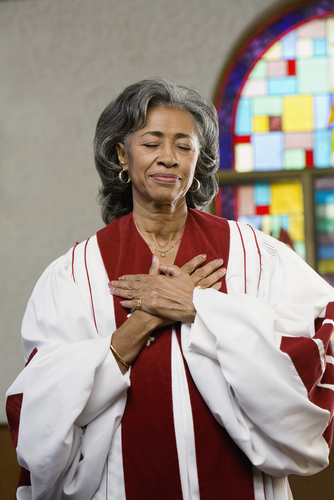 On Palm Sunday, my daughter carried the cross into an Episcopal sanctuary. She and the other acolytes also helped to pass out and regather the collection plates, light the candles, and support the priests during communion, supplying them with additional bread as needed.
On Palm Sunday, my daughter carried the cross into an Episcopal sanctuary. She and the other acolytes also helped to pass out and regather the collection plates, light the candles, and support the priests during communion, supplying them with additional bread as needed.
These are responsibilities she has assumed over the last several years as she faithfully serves her congregation as an acolyte once a month. She started at age ten, nervous and unsure. Now, nearly four years later, she confidently dons her white robe on acolyting days, certain of her role and participating joyfully in the life of her people.
OK, “joyfully” is admittedly a stretch. She is a teenager after all. But she is proud of herself, and I am proud of her; her church is teaching servant leadership.
I’ve been thinking all week of the sight of my daughter as an acolyte, presiding at the front of the church in her ritual clothing. It is an image I don’t see in my own church, where women don’t hold the priesthood and are therefore barred from leading most Christian rituals: blessing the Eucharist, baptizing new members, anointing the sick, conducting a worship service, officiating at temple ordinances, performing a marriage or funeral, or hearing confession.
So LDS women are grateful for small signs of progress. This weekend, for example, we are thrilled that a woman will likely pray aloud in General Conference for the first time in Mormon history.
In recent weeks there has been a rise in media attention to the question of LDS women’s ordination. (See here, here, and here.) Although the increasing visibility of this discussion might suggest that most Mormon women are now pushing for ordination, this is not the case, even among self-described feminists. According to sociological research recounted in American Grace, only 10% of Mormon women want the priesthood. What’s especially interesting about that research, however, is that nearly half—48%—of Mormon men favor ordaining women. (You can read the story of one such man, a current bishop, at the Ordain Women website.)
In other words, in answer to the specific question, “Do you think Mormon women should hold the priesthood and share equally in the administrative leadership of wards and stakes?” nearly every other Mormon man said yes.
Why?
A number of reasons have been put forward for this deep discrepancy in what Mormon men want for Mormon women and the far more modest hopes that Mormon women seem to harbor for themselves. Some have claimed that men are pragmatically selfish, hoping to share the burdens of leadership in an ecclesiastical structure that depends so heavily on long hours of volunteer labor. Others have pointed to a generational changing of the guard: church leadership is now passing into the hands of men who have successfully labored alongside women in the workplace and realize the invaluable contributions and insights that women can provide.
While I’m sure multiple factors come into play, I would propose my own: men know how much they have grown through holding the priesthood, and generously wish the same opportunity for their wives, sisters, and friends . . . and perhaps especially their daughters.
The priesthood changes lives because it is active, requiring those who bear it to rely upon God in new ways to face the challenges of serving others and building the kingdom. Exercising God’s power on earth is nothing less than a rehearsal for the vigorous eternity Mormons envision.
In the temple, Mormon men and women both experience the promise that they are anointed to become priests and priestesses in the hereafter, contingent upon their faithfulness. The words that are pronounced are the same. The difference is that under current policy, LDS men have their entire adult lives to ready themselves for this eternal role, and LDS women do not.
As a woman who has not always been a Latter-day Saint, what I know is that the years I spent in divinity school learning how to be a pastor—dispensing the bread and visiting the sick and discovering how to preach—taught me more about being a Christian than I could have gleaned from a book or realized vicariously through someone else’s performance of an ordinance.
It is as the old proverb says:
Tell me, I’ll forget.
Show me, I’ll remember.
Involve me, I’ll understand.
The real learning is in the doing, not just the receiving of other people’s acts.
This is why I stand for Mormon women’s ordination. I have seen what women’s ritual leadership has effected in myself, in my daughter, and in my female friends who are pastors. And more importantly, I have seen how such leadership changes entire congregations.
* Robert D. Putnam and David E. Campbell, American Grace: How Religion Divides and Unites Us (New York: Simon & Schuster), 242-244.
** Over the following weeks there will be two more installments in this blog series on Mormon women’s ordination.
*** The image of a Protestant woman pastor is used with permission of Shutterstock.com.





